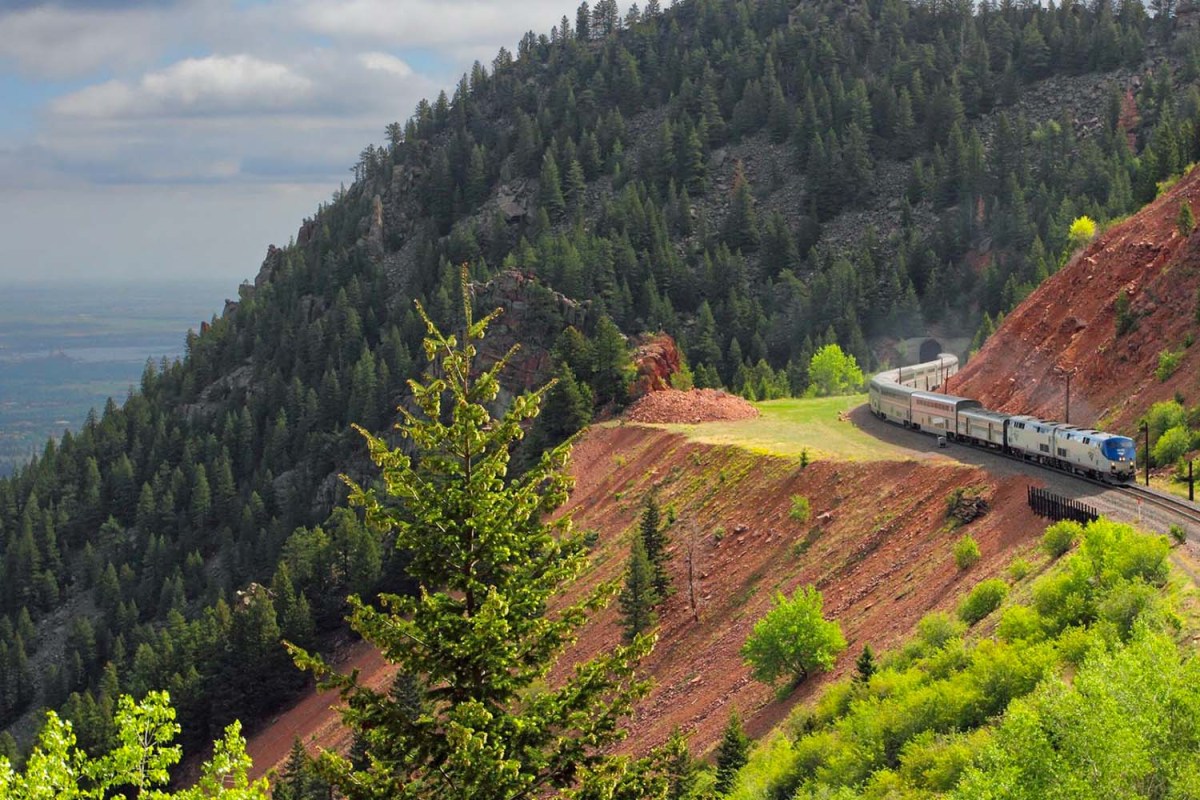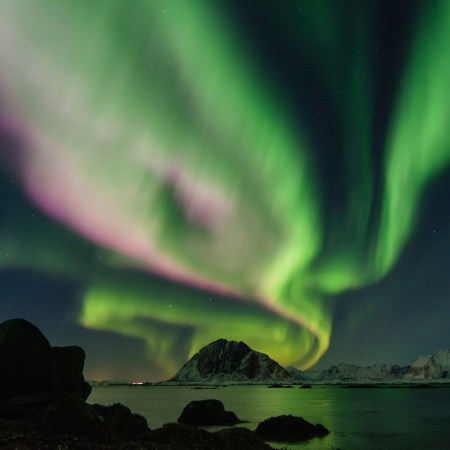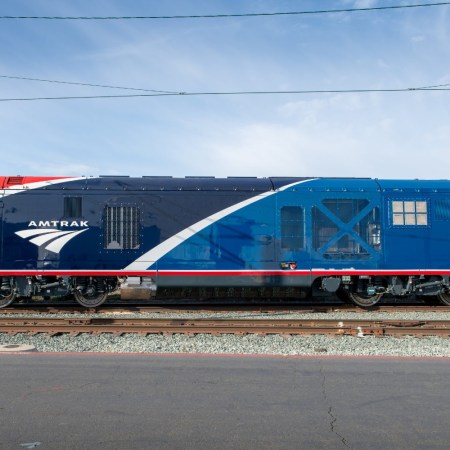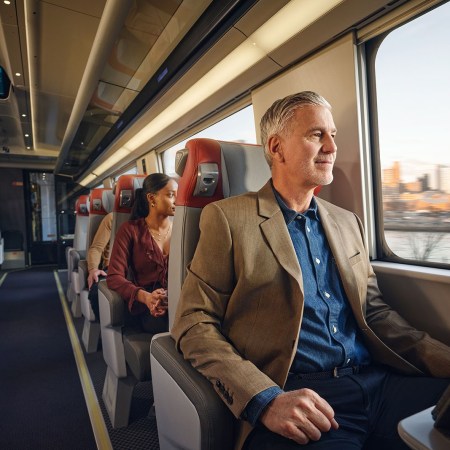I first learned about the California Zephyr from a song by Ben Gibbard and Jay Farrar, who, in turn, were paraphrasing Jack Kerouac’s novel Big Sur: “Now I’m transcontinental, 3,000 miles from my home,” Gibbard sings in his, as my buddy Scott Zuppardo describes, “nasally sweetness.” “I’m on the California Zephyr, watching America roll by.” It sounded blissful.
Today, the California Zephyr route is considered by many to be America’s most beautiful train ride. Beginning in Chicago, and over the course of 52 hours, it chugs through the middle of the country, traversing some of its most beautiful scenery before reaching its final stop in Emeryville, California. From there, passengers can take a bus to San Francisco.
I’ve always been curious about train travel, but it’s the kind of cross country-trip I would typically reserve for my camper van. A direct flight from my hometown of Indianapolis to the West Coast only takes about six hours, and while I can grit my teeth and get through it if I have to, I don’t like to be confined in a space for any length of time. How would I manage nearly two-and-a-half days on a train?
That said, I knew this particular train route would allow me to indulge the near-constant temptation to let my focus slide from the road to the incredible natural beauty surrounding me. On the train, I could take everything in without having to worry about causing a catastrophic crash. I decided to go for it.
A Guide to Taking a Luxury Train Across Canada
Take it from someone who’s done it: the undisputed best way to see the Great White North is by riding the rails and staying in the historic hotels along the wayAmtrak service to and from Indianapolis is severely limited — the same could be said about mass transit options throughout most of the Midwest, for that matter — so I started with a Greyhound bus to Chicago. Thanks to a massive medical convention and an even more massive Taylor Swift concert, I couldn’t get a hotel room near Union Station and was forced to overnight in a cut-rate Howard Johnson hotel near the airport. To paraphrase Rhett Miller, lead singer of the Old 97’s, “the room looked as good as it smelled.” And the room reeked. Imagine if a flatulent Jabba the Hut was eating burnt popcorn and smoking cut-rate cigarettes with the room temperature cranked to 100 degrees. It was that bad. Things could only get better from here, I thought. Right?
The next morning, I made my way to Union Station. Because I booked a roomette sleeper car, I had access to the Metropolitan Lounge. Unlike the folks sharing wooden pews in the Grand Hall, I could relax on a plush couch and graze on complimentary snacks. I particularly enjoyed the wall art, which evoked sights I would see during my trip.
When it was time to board, an Amtrak employee walked those of us in the lounge to the train. There were at least three sleeper cars, and my roomette was one of four on the bottom level of ours. The other passengers and I would all be sharing a few bathrooms and one shower. Larger pieces of luggage for the entire car were stacked on shelves in-between.
The roomettes did not appear to have changed much since Kerouac’s day. Mine, for its part, was a bit smaller than I anticipated — about 6.5 feet by 3.5 feet. Two chairs sat on opposite sides of the room facing each other and could be transformed into a bed. Above, a bunk bed could be lowered down. A tray table between the two seats was serviceable for dining or light work. What may be the world’s slimmest closet held two coat hangers and not much else. Despite what 1930’s noir thrillers had led me to believe, dinners on this train wouldn’t be formal. (On a side note: I heard a rumor that Amtrak may be updating the roomettes in the coming years. If so, Amtrak, call me. I have ideas.)
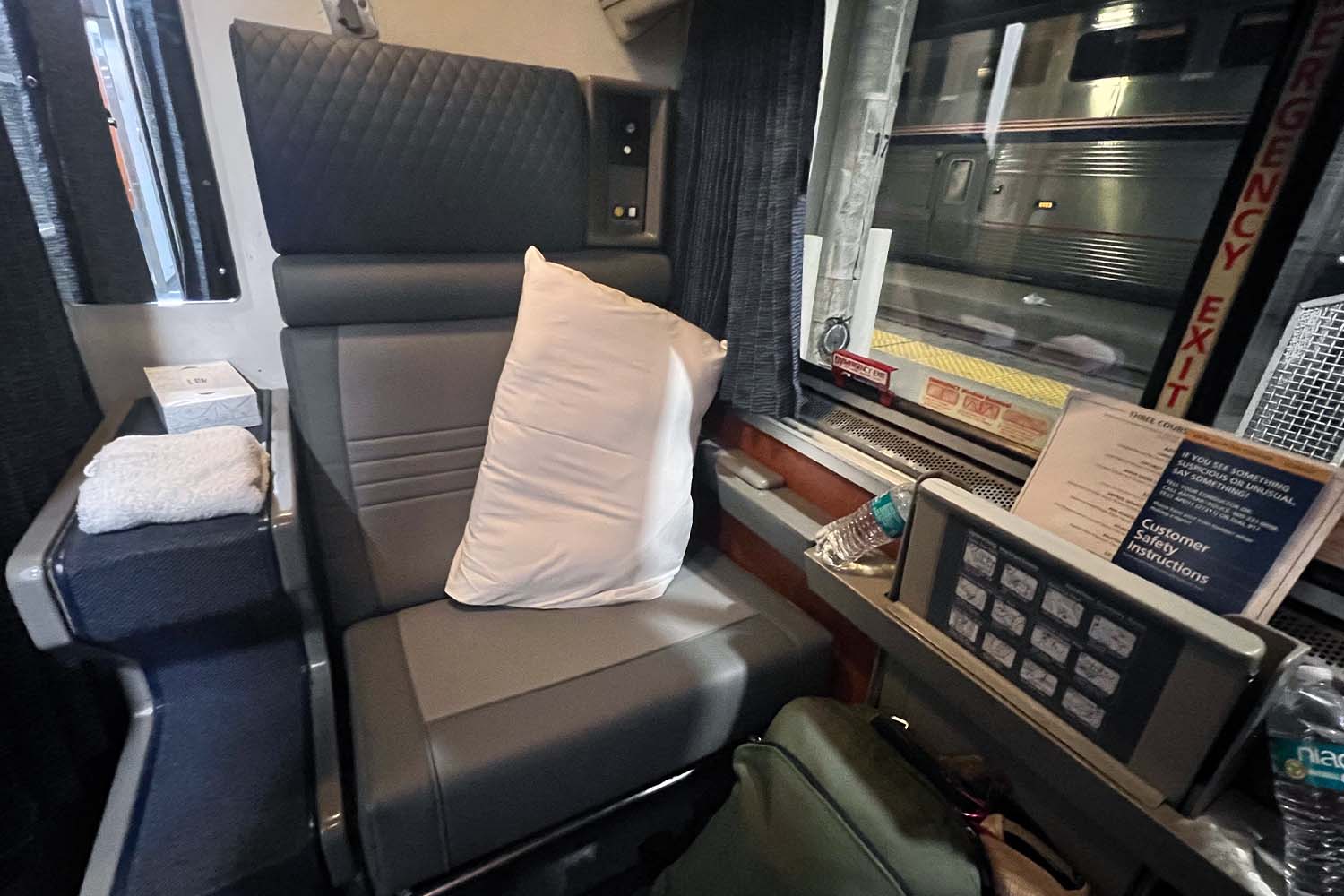
What’s more, the roomette had one electrical and no USB outlets (I would highly recommend bringing along an Anker Travel Power Strip), as well as temperature controls that didn’t seem to do much. Airflow alternated between nonexistent and the dying gasps of an asthmatic muskrat. And because we couldn’t open our windows, the lack of air conditioning made life in our small cabins a bit stifling. A few people actually went to the observation car to get a bit of sleep before dropping nighttime temperatures made it possible for them to return to their rooms.
Temperature aside, the roomettes were slightly less claustrophobic with the door open, which also helped give it a college dorm-like feel (minus the dude in the common room wearing a Baja hoodie and mangling “Wonderwall” on an acoustic guitar). For me, someone who travels alone in a camper van for a good chunk of the year, the cramped quarters weren’t an issue. However, if you’re a couple sharing a tiny cabin, be very sure of your relationship before clicking this option. (Though, actually, Amtrak may be missing out on a huge marketing opportunity: “On the fence about getting married? Book a cross-country trip trapped in a roomette and know for certain!”)
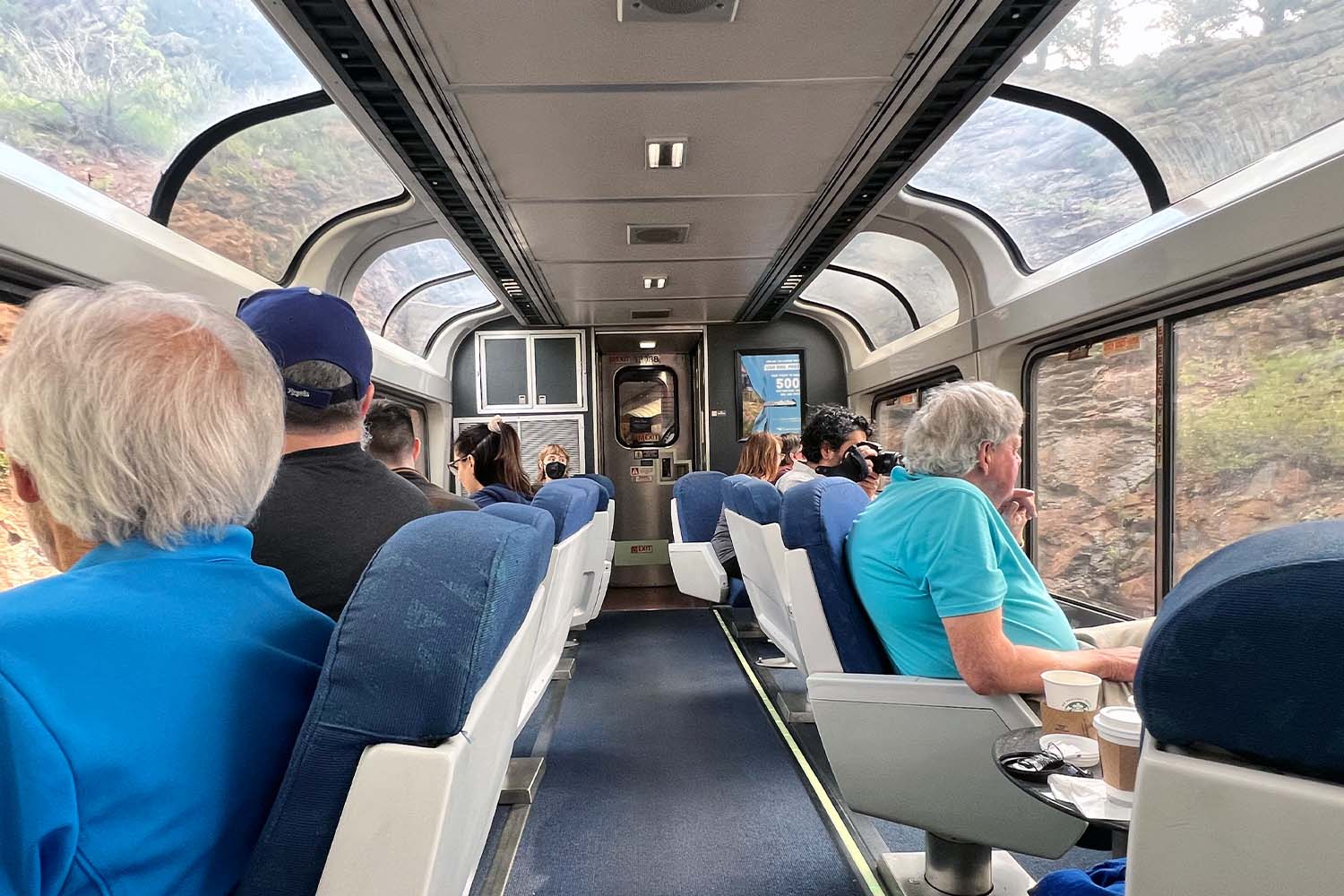
After we’d had a moment to settle in, Robert, the attendant for our sleeping car, gave us the lowdown. The observation car was one car beyond that, and Robert suggested we get there early the next morning, as the scenic stretch through Colorado was the busiest time. The dining car was one car over — we’d need to make reservations for dinner each evening, but both breakfast and lunch were first-come, first-served.
Meals are complimentary for sleeper cabin guests (bring along some cash for tips). Passengers have at least three or four different options for each meal — including dessert for lunch and dinner — as well as one alcoholic beverage or soft drink. The Amtrak chefs aren’t going to win any James Beard Awards, but my dinner companions and I agreed the food was much better than anticipated and miles above the best airline meal any of us had ever had. Tables are shared during meals, and unless you’re a family of four, you never know who you might be seated next to. Luckily every meal was filled with the warm conversation. Two of my favorite meals were shared with couples from England and Ireland, respectively, as we discussed the differences in train travel between the U.S. and Europe, as well as our favorite places to visit on either side of the pond.
I expected the California Zephyr to be filled with retirees, with impromptu bingo games breaking out throughout the train. Surprisingly to me, the Zephyr riders were a mix of ages and ethnicities. The mix was constantly changing as folks boarded and departed at every stop; I thought nearly everyone would want the full California Zephyr experience from Chicago to San Francisco, but most people were just doing shorter segments — Omaha to Salt Lake City, Grand Junction to Sacramento, and so on. I’d wager that more than half were repeat Amtrak passengers, some almost obsessively so. Michael Kimes from Rescue, California, told me he’s taken close to a dozen Amtrak trips over the years, half of which were on the Zephyr.
“There’s a definite camaraderie aboard,” Kimes says. “Normally in life I’m quite reserved, but here, I’m forced to be more of a social butterfly. You sit with people at dinner and learn their stories…Everyone’s much more relaxed as well. People get anxious when they’re about to fly and airports can be stressful. But on a train, everyone’s always smiling; even when the train is going at a virtual crawl, you’re always making forward progress.”
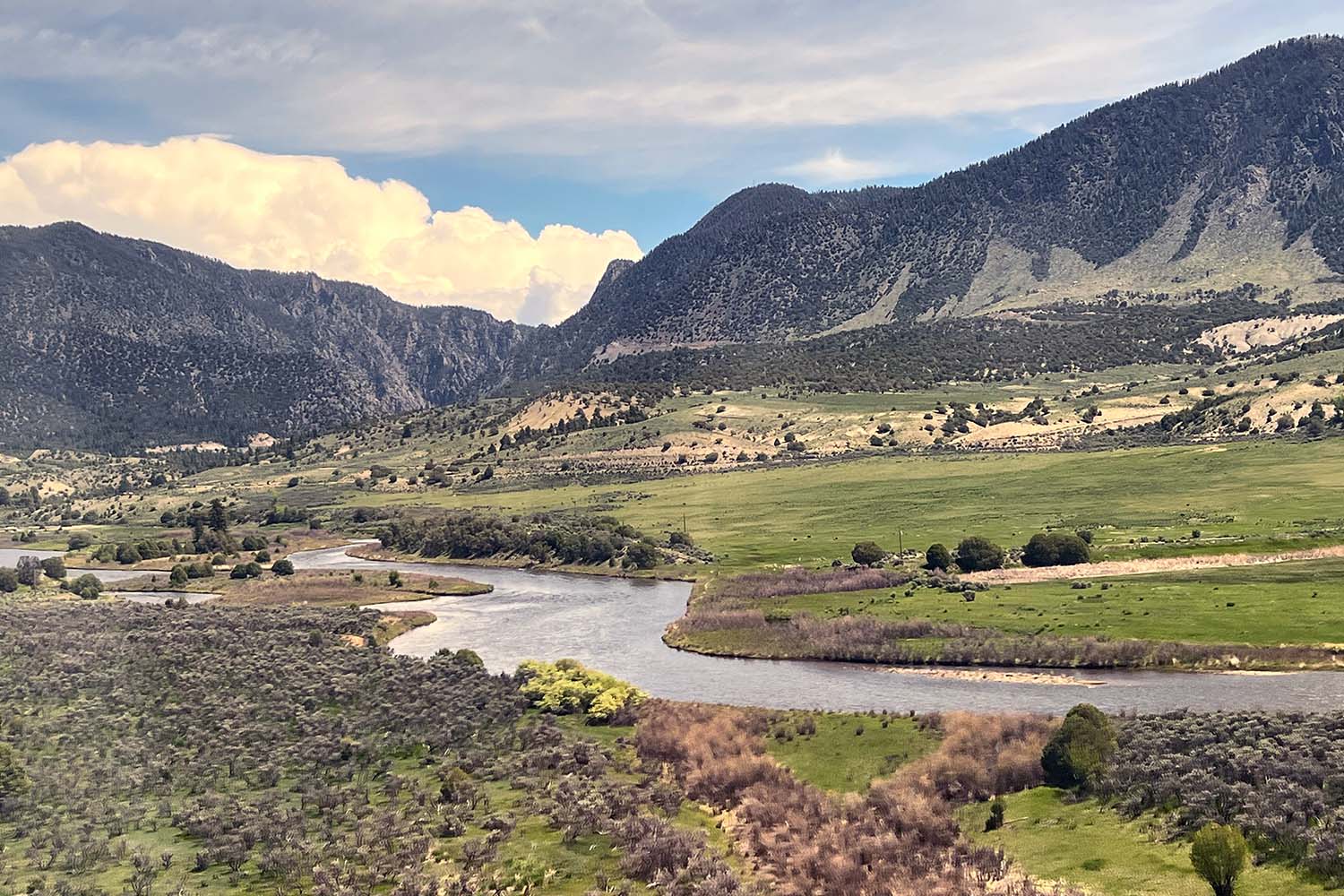
Although the massive granite mountains and fast-flowing rivers get most of the attention on this trip, coming out of Chicago, you’re rolling through the everyday America that John Cougar Mellencamp sings about — family farms, American Legion halls, industrial grain silos, rusted-out vintage Ford pickups disappearing into brambles of weeds and gravel roads stretching out to everywhere and nowhere. There’s a charm there that many folks may overlook, but I absolutely adore. I loved catching split-second glimpses of everyday life in these small towns. Would I buy the owner of Moore Tires a beer at the Shamrock Pub after he hooked me up with a great deal on a new set of winter radials? Who was playing the slots at Ziggie’s right now? Was someone cooking meth in that dilapidated trailer?
Per Robert’s admonition, however, on day two I woke up around 5:30 a.m., as the moon slowly sank toward, and finally below, the horizon. After breakfast and our stopover in Denver, I camped out in the observation car as we began left out of the green meadows and up into the Rockies. As we chugged up the granite mountains, we passed an undulating stream of Douglas fir, lodgepole pine, quaking aspens, blue spruce trees and fast-moving whitewater rivers. We were surrounded by arboreal beauty everywhere.
The sounds of the observation car then wasn’t unlike that of the sounds of an audience watching an action movie — lots of “oohs” and “ahhs,” punctuated by the occasional “wow!” For this stretch, I’d recommend people try to sit on the right side of the observation car — at least for the first 90 minutes or so — then, if possible, switch to the left side. Depending on the sun’s angle, you may have strong reflections on the glass, which may make taking photographs difficult.
From there, the Zephyr crossed over the Continental Divide (or rather under it). The Moffat Tunnel passes underneath James Peak, which left us in the dark for 6.2 miles. Before we entered the tunnel, we were asked to stay seated and not move around. Thankfully, also unlike those ’30s noir thrillers, no one had a knife sticking in their back once we reached daylight again.
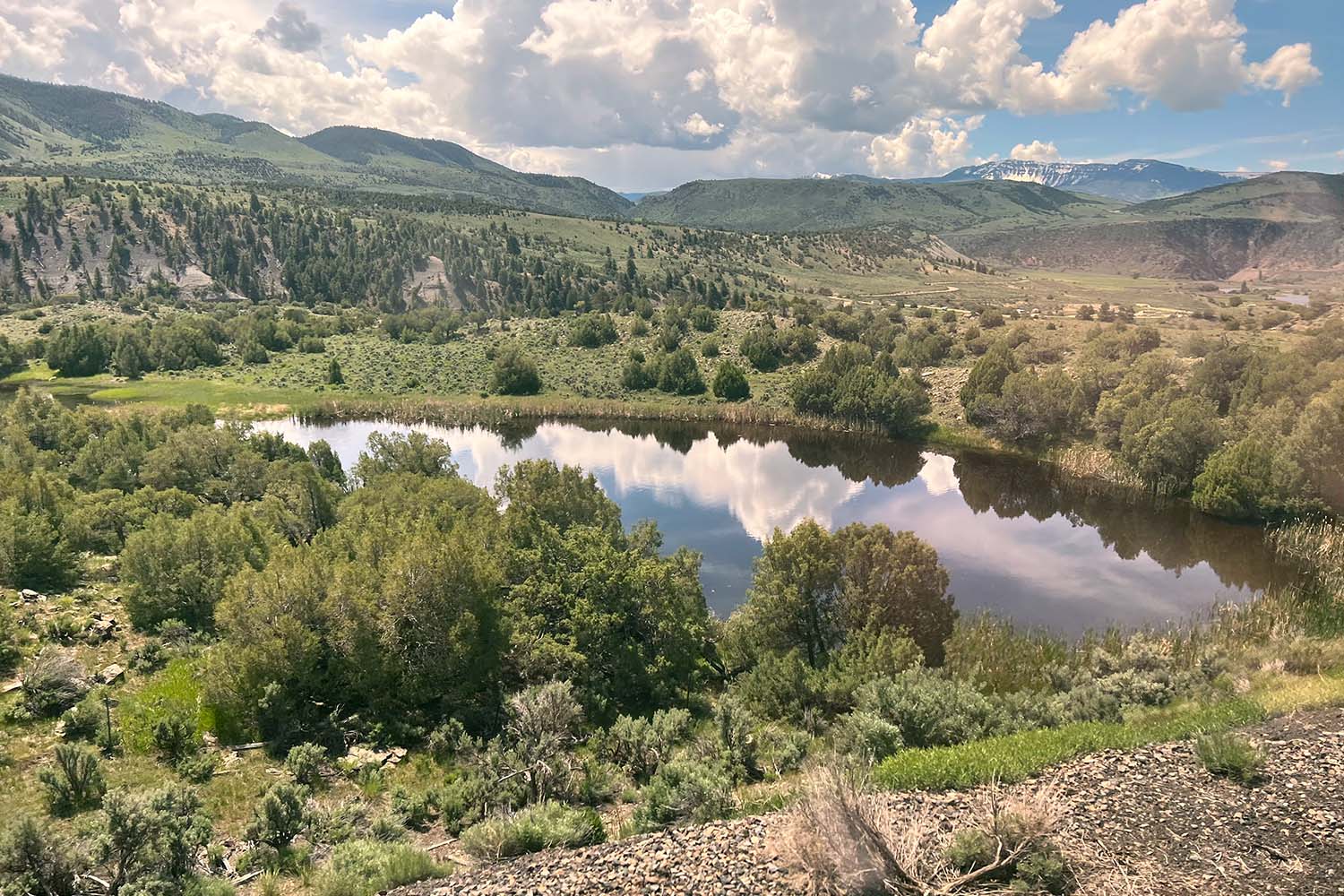
Descending back down to nearly sea level, we paralleled the Colorado River for what felt like hundreds of miles. We saw dozens, if not hundreds, of anglers and paddlers having fun on the river, and nearly as many butt cheeks. That section of the Colorado is affectionately referred to as “Moon River,” we were told as person after person dropped trou and wiggled their bottoms at the passing train.
Colorado would eventually give way to Utah’s sun-bleached sandstone with the snow-capped Wasatch mountains towering in the distance to Nevada’s juniper-filled high desert to California’s High Sierras. The tall pines cover the hills and mountains of Tahoe National Forest, where pockets of snow remained from the brutal winter.
We passed right by the dazzlingly green Donner Lake, where the infamous Donner Party was stranded during an even more vicious winter. Craig Genet, of Springfield, Ohio, said he’s been fascinated by the macabre story lately and was thrilled to learn the location was along the Zephyr’s route. This was his first cross-country journey on a train. He was in the coach section, and sleeping in the less-crowded bottom level so he can spread out to sleep and relax.
“Coach seems to be a bit more communal than the sleeper cars,” Genet told me. “People are much friendlier than I expected. It seems like more of a shared experience.”
At every stop, I stepped outside to grab some fresh air. Most stops lasted only a few minutes, just long enough to load and unload passengers. We had slightly longer stops in both Denver and Salt Lake City, each lasting about 30-40 minutes. But between reading books and watching YouTube videos in my roomette and scenery watching in the observation car, I didn’t get as stir crazy as I feared. As we hurtled our way to the journey’s end, I asked myself, “Would I do it again?”
The answer? Definitely. Despite the inconveniences, I loved the experience. Next time, I might go with an open coach ticket and segment the trip a bit more. So many places we passed, I was curious whether or not any trout were biting on a river or where a particular trail led into the hills hurtling past us.
Sacramento would be my final stop on that trip. Like in the song, I’d gone transcontinental — 3,000 miles (OK, more like 2,174) from my home while watching America roll by. When I hear people talk about the “romance of the rails” now, I totally get it. It’s all about falling in love with the ever-changing landscape. Seeing America from the rails made me appreciate how incredibly beautiful and special it can be. Maybe I’ll write a song about it.
This article appeared in an InsideHook newsletter. Sign up for free to get more on travel, wellness, style, drinking, and culture.
